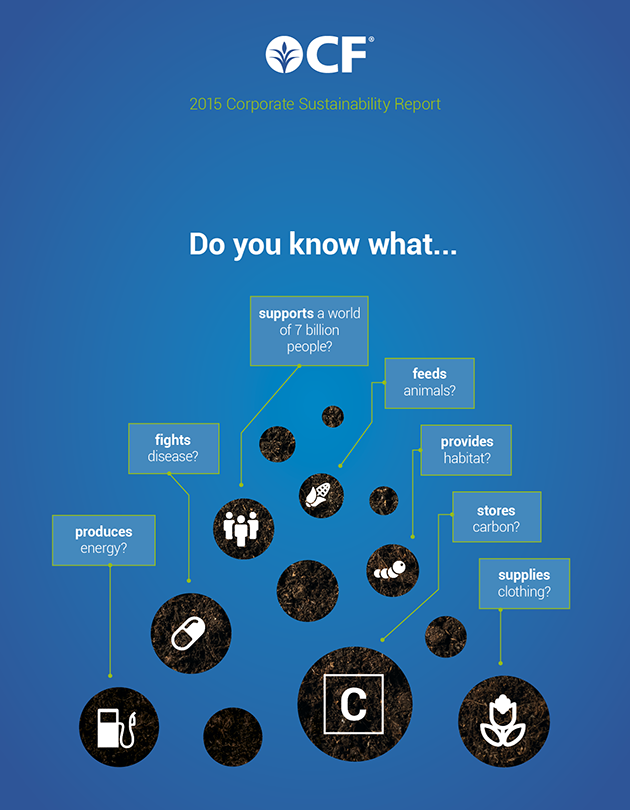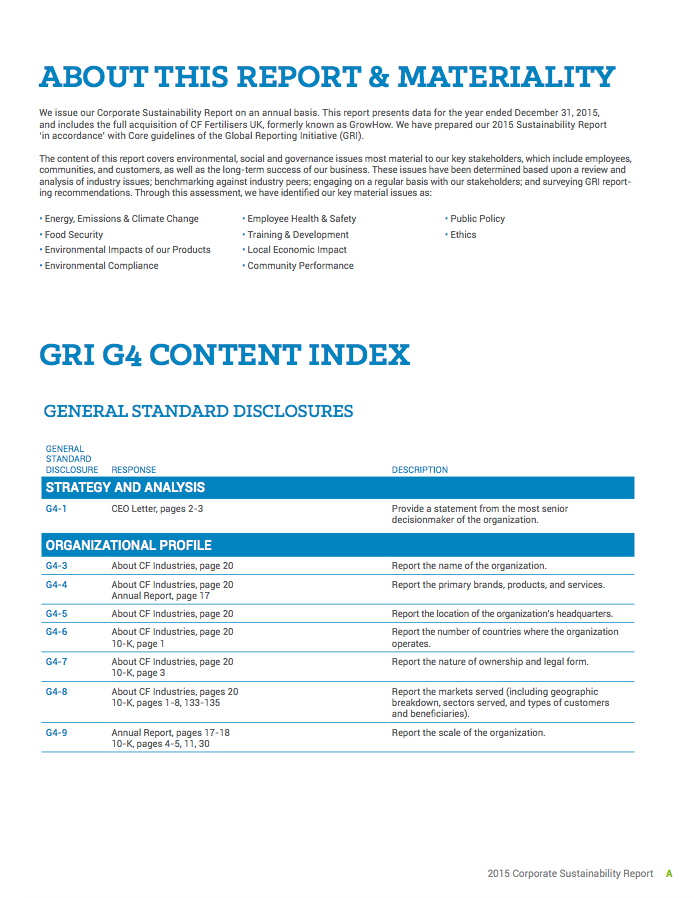President and
Chief Executive Officer
To Our Stakeholders
The past 12 months have been a period of significant growth — growth that is tied directly to CF’s ability to meet the world’s need to feed itself and future generations sustainably.
During 2015, our capacity expansion projects in the United States began to come online. Once complete in 2016, we will have increased our nitrogen capacity by more than 25 percent in North America. Also in 2015, we became the largest nitrogen producer in the United Kingdom through the acquisition of the outstanding interest in a joint venture there. As a result, our company will soon have the capacity to produce annually enough nitrogen fertilizer to support crop yields that can sustain the nutritional needs of more than 250 million people.
The environmental benefits of this capacity are equally important to appreciate. Our nine manufacturing complexes are among the lowest-cost and lowest carbon-emitting producers of nitrogen fertilizers in the world, thanks to their use of clean natural gas, their world-class scale and their energy-efficient technology.
The Risks of Regional Regulation
60%
Almost Two-Thirds of Food Production Today is Made Possible by the Effective Use of Fertilizer
In contrast, many nitrogen producers in other parts of the world, particularly in China, use anthracite coal as their main feedstock as opposed to natural gas. A tonne of urea, a basic nitrogen fertilizer product, produced in that type of plant, emits on average more than three times the CO2 per product tonne than a tonne of urea produced in North America from natural gas.
That’s why it’s important for any regional carbon pricing mechanism, such as cap and trade, to fully consider both the economic and environmental dynamics of global commodities markets. Capacity removed due to regulation from one region will be replaced by capacity in another region. In our industry, that replacement capacity likely will be anthracite coal-based production and will generate significantly higher emissions than the removed capacity, negating any global benefit from regional regulation.
State-of-the-Art Efficiency & Safety
9 Billion
Global Population by 2050
As we have expanded capacity over the past four years, we not only have invested in state-of-the-art control technologies for new facilities, but also upgraded existing plants at our Donaldsonville, Louisiana, and Port Neal, Iowa, manufacturing complexes. For example, a new plant in Donaldsonville has installed technology that reduces nitrous oxide emissions, a greenhouse gas, by 94 percent. These investments also offer further improvements to the energy efficiency and safety of our operations at these facilities.
Across all CF locations, safety remains our highest priority and a foundational strength. In 2015, and for the second consecutive year, we recorded our best-ever safety performance by all measures. To support continued success, we rolled out a new safety strategy that includes an annual program, the Stephen R. Wilson Excellence in Safety Award, to engage and recognize employees who further our safety culture through innovation.
70%
More Food Needed to Meet Nutritional Demands
Investments that support capacity expansions, leading-edge technologies and safety programs reflect an underlying business that remains exceptionally strong. Even in a weak market with pricing pressures, CF generated $2 billion in adjusted EBITDA during 2015. We’re gratified to be in a position in which we have invested over $6 billion to expand our business over the past five years, while at the same time returning over $5 billion to shareholders in the form of share repurchases.
Feeding a Hungry World Efficiently and Responsibly
The year also saw us ship more than 13.7 million tons of nitrogen-based fertilizer products, the vast majority of which ended up as nutrients in the soil of farms across North America and around the world. No matter what else we accomplish in a given year, this is our most important calling — helping farmers feed the crops that feed the world.
Our products and other synthetic fertilizers enable farmers to be more efficient stewards of their land by increasing yields per acre. A greater yield per acre not only results in greater food security for the world’s population, but also contributes to lower green-house gas emissions for the planet. When forestland must be converted to agricultural use, the critical carbon sequestration role of trees is lost.
As the graphic illustrates, crop yields and land use are important dynamics to keep in mind as the world seeks to solve the carbon equation.
Working With Stakeholders to Find Solutions
2X
Nearly Twice as Much Food Will Need to be Produced in Developed Countries
CF is committed to contributing greenhouse gas mitigation solutions, as well as conservation of all natural resources. In Iowa, for example, we are partnering with The Nature Conservancy on a landmark project to spread awareness among farmers and empower them to keep crop nutrients in their soil and out of water supplies. The idea is to bring all stakeholders to the table to implement viable solutions that work both environmentally and economically for farmers. This initiative complements our longstanding and ongoing support of industry stewardship programs.
There’s no doubt that our world faces daunting challenges as it seeks ways to balance the needs of a growing global population with the stresses that those needs place on our natural environment. We believe that successful pathways can be found when we tackle these challenges in the same manner in which we run our business — engaging with each and every stakeholder, considering the big picture, seeking efficiencies and always taking a “Do It Right” approach.

W. Anthony Will
President and Chief Executive Officer



